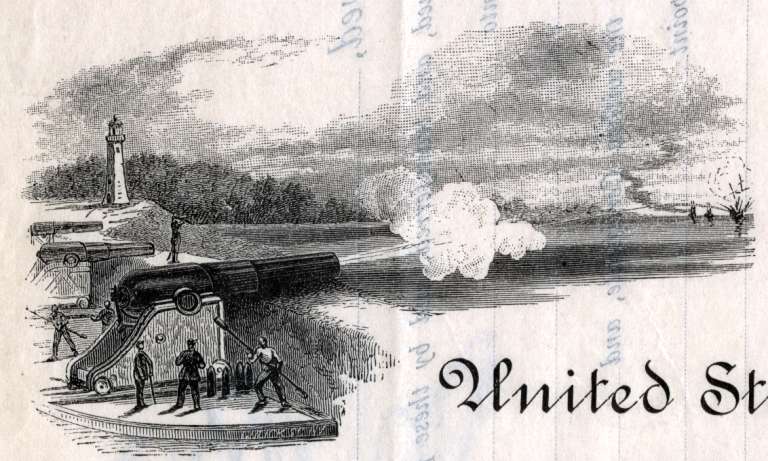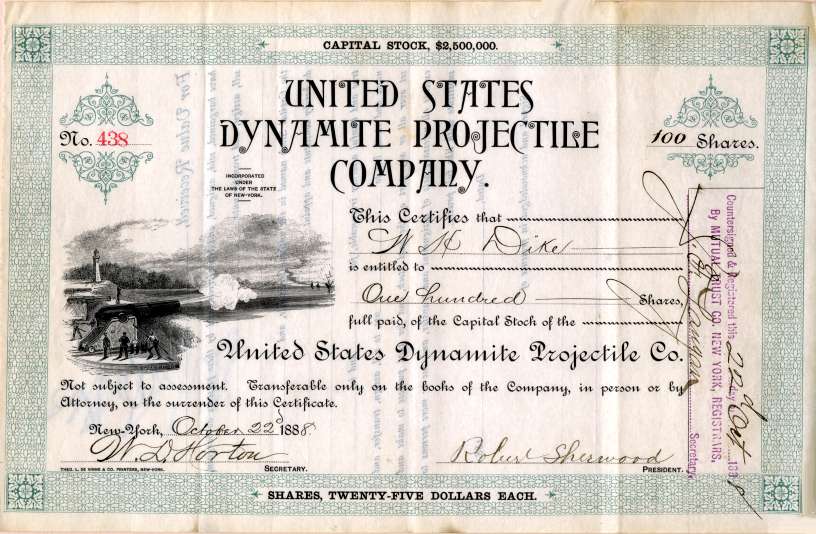Beautiful RARE stock certificate from the United States Dynamite Projectile Company issued in 1888. This historic document was printed by the Theo. L. De Vinne & Co. Printers, New York and has an ornate border around it with a vignette of a cannon firing at a ship in a bay. This item has the signatures of the Company's President, Robert Sherwood and Secretary, W. L. Horton. 
Certificate Vignette 
Certificate The United States Dynamite Projectile Company was incorporated under New York state laws, with a capitalization of $2,500,000. The company manufactured the Snyder dynamite projectile. Farrow's military encyclopedia: a dictionary of military knowledge 1895 SNYDER DYNAMITE PROJECTILE.--A newly invented shell charged with a powerful explosive and designed to be propelled from an ordinary camion. Since the time (1805) when Robert Fulton.in an experimental trial, blew up a brig in Deal Harbor, England, with two torpedoes, filled with 180 pounds of gunpowder, by means of clock-work, the subject of torpedoes, especially for naval warfare, has commanded the attention of civilized governments, and inventions and improvements in this line have been the study of many inventors. England, from the time Fulton made his torpedo experiment, has looked with a jealous eye upon inventions in this direction. Earl St. Vincent, in speaking of the subject to Fulton, said of Sir William Pitt, who had encouraged Fulton in his trials, that he (Pitt) "is the greatest fool that ever existed, to encourage a mode of war which they, who commanded the seas, did not want, and which, if successful, would deprive them of it." That this anxiety still exists, not only in England, but among all other maritime powers, is shownl by the large expenditure of money that is constantly being made in the manufacture of torpedoes. The invention of nitro-glycerine and its adjuncts, nitro-gelatine, dynamite, forcite, giant powder, etc., gave torpedoes a fresh impetus, its destructive effect being much greater than gunpowder. But nitro-glycerine, with its kindred compounds, is of such a sensitive nature that a sudden blow or shock will cause its explosion. Consequently their uses heretofore for war purposes have been solely confined to what are known as fixed submarine mines, floating and spar torpedoes,and torpedoes propelled by machinery contained within them, or by rockets. Fixed mines, especially when placed under water, are unreliable, and should a vessel pass over them, they could seldom be exploded at the right moment, if at all. Floating torpedoes are quite as apt to injure friends as foes, and the invention of machineguns and electric lights renders the destruction of spar torpedoes or the thwarting of their operation easy and certain by skilled gunners before they could come into dangerous proximity to a vessel. Locomotive, or machine torpedoes, likewise have their defects. Their manipulation is intricate and uncertain, and their range short. Of this class is the Fish or Whitehead torpedo,and notwithstanding the fact that millions of dollars have been expended in their construction and trial in war, we understand no vessel has yet been destroyed or injured by one of them. The late Commodore Wm. N. Jeffers, of the U. S. Navy, in speaking of this class of torpedoes, very aptly remarked: 'They will go like the devil, but where in the devil will they go to?" What is known as the Lay.or controllable, torpedo, has overcome many of the objections that apply to the others, yet in that implement many improvements must be made before it can be considered an effective and reliable weapon of war, and even then, like its associates, it would only be applicable to naval warfare. Realizing the importance of torpedoes for coast defense, the United States Government has encouraged their development, and for the torpedo stations of their Army and Navy--at Willett's Point and Newport--there was appropriated by Congress during the years 1871 and 1879, inclusive, the sum of two million sixty-nine thousand dollars. It has never been disputed by those whose opinions were worthy of consideration that, if shells or projectiles, charged with dynamite or analogous highly explosive compounds, could be safely tired from cannon, it would revolutionize the present system of warfare, especially of a maritime character. An invention has recently been perfected by which dynamite can be made to play a more important part in offensive and defensive land or naval warfare than it has hitherto been possible to attain. It consists in loading a shell or projectile with glycerine, dynamite or other high explosives, and tiring the same from any ordinary gun or cannon without explosion until it strikes the object at which it is fired. The inventor accomplishes this purpose by the mechanical devices that are absolutely certain in their operations; far more so than the shells charged with gunpowder and exploded by time-fuses or other devices, and attended with less danger to those who use them. Repeated tests of this invention have been made which, in the opinion of experienced naval and military officers who have witnessed the trials, place the utility of the system beyond the realm of doubt. By this system sufficient dynamite to sink the heaviest armored iron-clad ever floated can be fired in a single projectile. No special kind of ordnance is required, as the invention is applicable to either breech or muzzle-loading, smooth-bore, or rifled-cannon. By tins system no shock is produced upon the projectile, and consequently less strain upon the gun than in the ordinary methods of firing. The inventor is prepared to demonstrate that with uniform weight projectiles, a longer range and greater accuracy is attainable with the same gun than by the usual methods of firing. It is confidently believed, and the United States Dynamite Projectile Company is willing to prove, by competitive tests, that they can produce a more destructive effect with a gun of six-inch caliber, using the Snyder dynamite-projectile, than can be produced with a cannon of the largest caliber ever fabricated, using the ordinary projectile or solid shot. When the saving in weight of armament of a war vessel, that may be attained by this invention is considered, its benefits will be appreciated, especially when increased speed and facility of maneuvering is desirable. The effect produced by firing shells charged with dynamite into an enemy's camp, or fortified position, or city, can easily be imagined by any one familiar with the terrible destructiveness of exploded dynamite. However, those who have never witnessed its explosion when fired from cannon, will have a very meager conception of its havoc, as the tamping or solidifying it receives at the point of contact and explosion, by reason of the velocity with which the shell is driven, intensifies the deflagration, and augments its destructive effect. It will, furthermore, be readily apparent that the concussive effect produced by the explosions of dynamite shells would be disastrous to life within a very considerable radius. It has been suggested that explosive compounds, in the manufacture of which nitro-glycerine is used as a base or component part, will be extra hazardous to transport or handle. This objection may seem reasonable to those having little knowledge of its nature, yet it is well known by those familiar with its character, that in many respects there is far less danger attending its transport, handling, and storage, than there is with ordinary gunpowder, as properly manufactured compounds of nitro-glycerine coming in tact with fire, if unconfined, will simply burn, while gunpowder will instantly explode. Furthermore, many of the glycerine compounds, notably nitro-elycerine, for storage, may be placed in water, for instance, in the hold of a vessel, out of the way of an enemy's shot, where it may remain for years without deterioration, or until required for charging the projectiles. The preliminary trial at the Washington Navy Yard of the Synder dynamite-shell, using gunpowder as the projectile agent, was had very recently under the auspices of the Senate Military Committee. The gun used was a six-inch rifled breech-loading howitzer of the Moffat pattern. The shell was loaded with twelve pounds of explosive gelatine, containing 95 per cent, of pure nitro-glycerine. The tiring-charge was the maximum that the gun would take, and was of common hexagonal powder. The projectile struck the target, exploding with a force that completely shattered both target and backing. The concussion of the air in the vicinity was terrific. History from Encyberpedia and OldCompany.com (old stock certificate research service)

Certificate Vignette

Certificate
1 Review Hide Reviews Show Reviews
-
U S Projectile and Dynamite Co
Wanted this piece for some time. Arrived well packaged and exactly as expected. Excellent vendor










